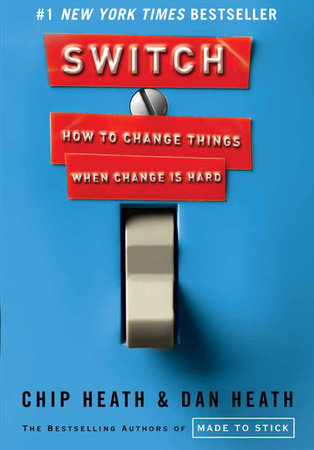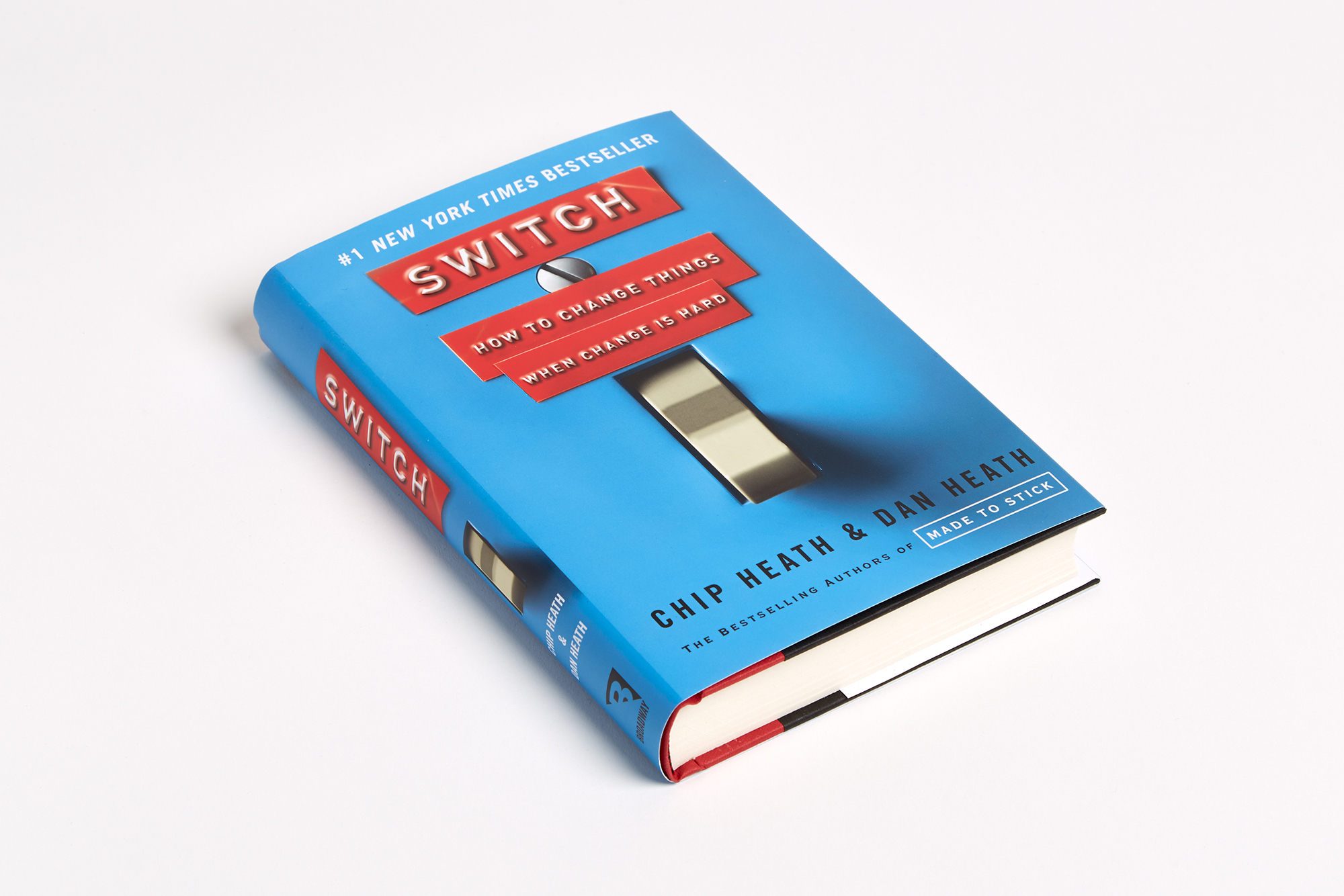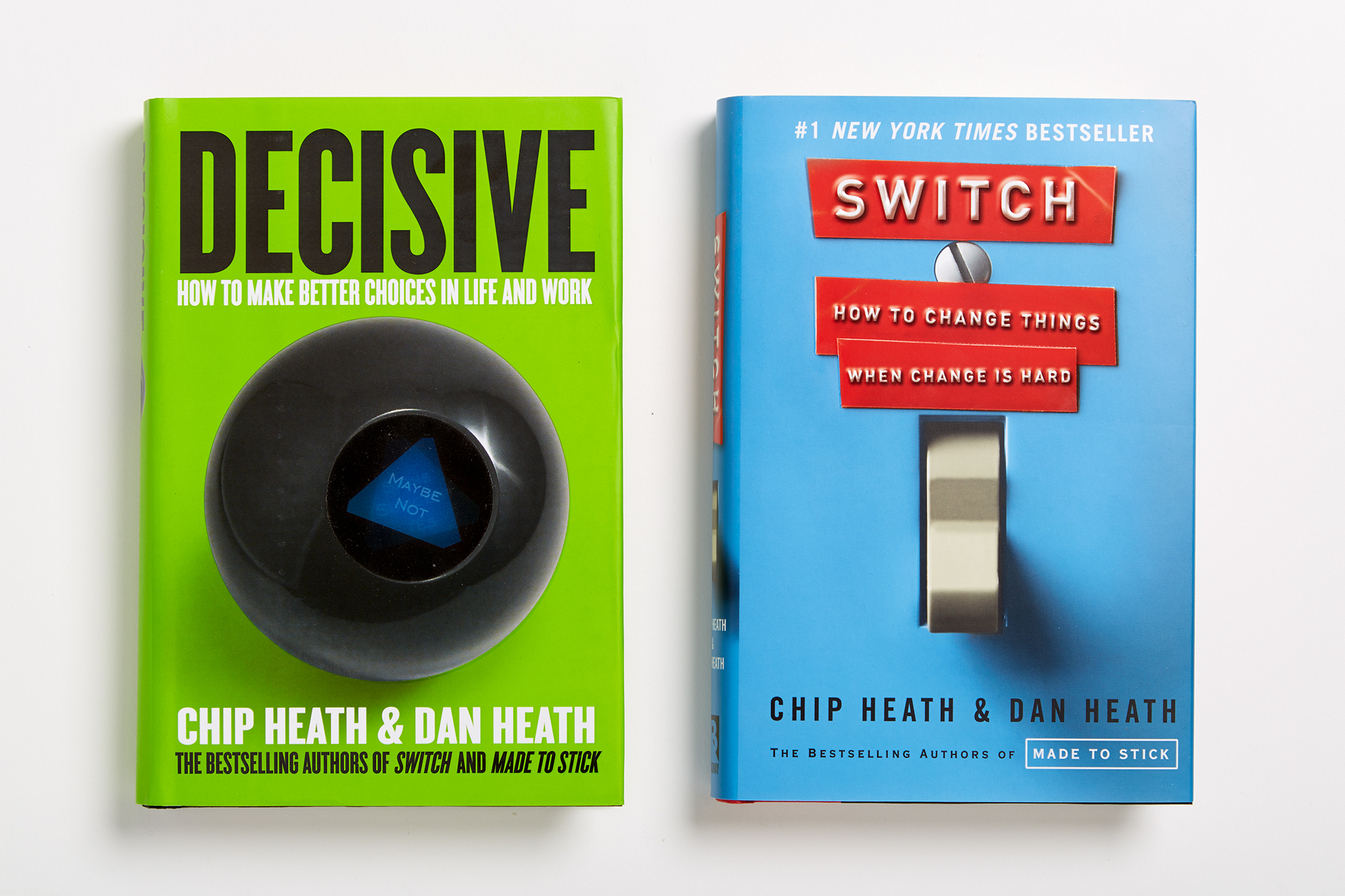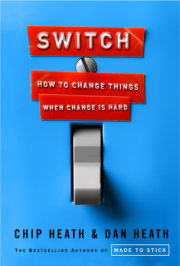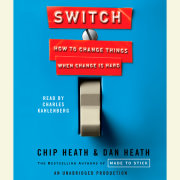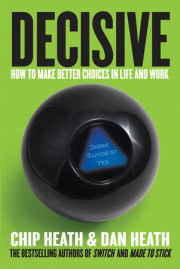Chapter 1
The Three Surprises About Change
1.
One Saturday in 2000, some unsuspecting moviegoers showed up at a suburban theater in Chicago to catch a 1:05 P.M matinee of Mel Gibson's action flick Payback. They were handed a soft drink and a free bucket of popcorn and asked to stick around after the movie to answer a few questions about the concession stand. These movie fans had unwittingly entered a study of irrational eating behavior.1
There was something unusual about the popcorn they received. It was wretched. In fact, it had been carefully engineered to be wretched. It'd been popped five days earlier and was so stale that it squeaked when you ate it. One moviegoer later compared it to Styrofoam packing peanuts, and two others, forgetting that they'd received the popcorn for free, demanded their money back.
Some of them got their free popcorn in a medium-sized bucket, and others got a large bucket--the sort of huge tub that looks like it might once have been an above-ground swimming pool. Everybody got their own individual bucket so there'd be no need to share. The researchers responsible for the study were interested in a simple question: Would the people with bigger buckets eat more?
Both buckets were designed to be so big that no one could finish their portion. So the actual research question was a bit more specific: Would somebody with a larger inexhaustible supply of popcorn eat more than someone with a smaller inexhaustible supply?
The sneaky researchers weighed the buckets before and after the movie, so they were able to measure precisely how much popcorn each person ate. The results were stunning: People with the large buckets ate 53 percent more popcorn than people with the medium size. That's the equivalent of 173 more calories and approximately 21 extra hand-dips into the bucket.2
The author of the study, Brian Wansink, runs the Food and Brand Lab at Cornell University and he described the results in his book Mindless Eating: "We've run other popcorn studies, and the results were always the same, however we tweaked the details. It didn't matter if our moviegoers were in Pennsylvania, Illinois, or Iowa, and it didn't matter what kind of movie was showing; all of our popcorn studies led to the same conclusion. People eat more when you give them a bigger container. Period."
No other theory explains the behavior. These people weren't eating for pleasure. (The popcorn was so stale it squeaked!) They weren't driven by a desire to "finish their portion." (Both buckets were too big to finish.) It didn't matter whether they were hungry or full. The equation is unyielding: Bigger container = more eating.
Best of all, people refused to believe the results. After the movie, the researchers told the moviegoers about the two bucket sizes and the findings of their past research. The researchers asked, do you think you ate more because of the larger size? The vast majority scoffed at the idea, saying things like, "Things like that don't trick me," or "I'm pretty good at knowing when I'm full."
Whoops.
2.
Imagine that someone showed you the data from this study but didn't mention the bucket sizes. On your data summary, you'd see how much popcorn each person ate. You could quickly scan the results and see the differences--some people ate a little bit of popcorn, some ate a lot, and some seem determined to test the physical limits of the human stomach. Armed with a data set like that, you would have found it easy to jump to conclusions. Some people in the world are Reasonable Snackers and others are Big Gluttons.
A public health expert, studying that data alongside you, would likely get very worried about the Gluttons. We need to motivate these people to adopt healthier snacking behaviors! Let's find ways to show them the health hazards of eating so much! And maybe we should approach state legislators about a Big Bucket Ban!
But wait a second. If you want people to eat less popcorn, the solution is pretty simple: Just give them smaller buckets. You don't have to worry about their knowledge or their attitudes.
You can see how easy it would be to turn an easy change problem (shrinking people's buckets) into a hard change problem (influencing people's motivation or understanding, or changing the law). And that's the first surprise about change: What looks like a people problem is often a situation problem.
3.
This is a book to help you change things when change is hard. We'll consider change at every level--individual, organizational, and societal. Maybe you want to help your brother beat his gambling addiction. Maybe you need your team at work to act more frugally because of market conditions. Maybe you wish more of your neighbors would bike to work.
Usually these topics are treated separately--there is "change management" advice for executives and "self-help advice" for individuals and "change the world" advice for activists. That's a shame, because all change efforts have something in common: For anything to change, someone has to start acting differently. Your brother has got to stay out of the casino; your employees have got to start booking coach fares. Ultimately, all change efforts boil down to the same mission: Can you get people to start behaving in a new way?
We know what you're thinking--people resist change. But it's not quite that easy. Babies are born every day to parents who, inexplicably, welcomed the change. Think about the sheer magnitude of that change! Such an idea would never fly in the work world: Would anyone agree to work for a boss who'd wake you up twice a night, screaming, for trivial administrative duties? And what if, every time you wore a new piece of clothing, the boss spit up on it? Yet people don't resist this massive change--they volunteer for it.
Enormous changes are all around us, and they often come voluntarily--not just babies, but marriages and new homes and new technologies and new job duties. Meanwhile, other behaviors are maddeningly intractable. Smokers keep smoking and kids grow fatter and your husband can't ever seem to get his dirty shirts into a hamper.
So there are hard changes and easy changes. What distinguishes one from the other? In this book, we'll argue that successful changes share a common pattern--they require the leader of the change to do three things at once. We've already seen the first of those three things: To change someone's behavior, you've got to change their situation.
The situation isn't the whole game, of course. An alcoholic might go dry in rehab, but what happens when they leave? Your sales reps might be hyper-productive when the sales manager shadows them, but what happens afterward? For someone's behavior to change, you've got to influence not just their environment but their hearts and minds. The trick is this: Often the heart and mind disagree. Fervently.
4.
Consider the Clocky. It's an alarm clock invited by an MIT student and now manufactured by Nanda Home. It's no ordinary alarm clock--it has wheels. You set it at night and in the morning when the alarm goes off, it rolls off your nightstand and scurries around the room, forcing you to chase it down. Picture the scene: You're crawling around the bedroom in your underwear, stalking and cursing a runaway clock.
Clocky ensures that you won't snooze-button your way to disaster. And apparently that's a common fear, since about 35,000 Clockys have sold, at $50 each, in its first 2 years on the market.
The success of this invention reveals a lot about our psychology. What it means, fundamentally, is that we are schizophrenic. Part of us--our rational side--wants to get up at 5:45 a.m., allowing plenty of time for a quick jog before we leave for the office. The other part of us--the emotional side--wakes up in the darkness of the early morning, snoozing inside a warm cocoon of sheets and blankets, and wants nothing in the world so much as a few more minutes of sleep. If, like us, your emotional side tends to win these internal debates, then you might be a potential Clocky customer. The beauty of the device is that it allows your rational side to outsmart your emotional side. It's simply impossible to stay cuddled up under the covers when there's a rogue alarm clock rolling around your room.
Let's be blunt here: Clocky is not a product for a sane species. If Spock wants to get up at 5:45 a.m., he'll just get up. No drama required.
Our built-in schizophrenia is a deeply weird thing, but we don't think much about it, because we're so used to it. When we kick off a new diet, we toss the Cheetohs and Oreos out of the pantry, because our rational side knows that when our emotional side gets a craving, there's no hope of self-control. The only option is to remove the temptation altogether. (For the record, some MIT student will make a fortune designing Cheetohs that scurry away from people when they're on a diet.)
The unavoidable conclusion is this: Your brain isn't of one mind.
The conventional wisdom in psychology, in fact, is that our brains have two independent systems at work at all times. First, there's what we called the emotional side. It's the part of you that is instinctive, that feels pain and pleasure. Second, there's the rational side, also known as the reflective or conscious system. It's the part of you that deliberates and analyzes and looks into the future.
Psychologists have learned a lot about these two systems in the past few decades, but of course mankind has always been aware of the tension. Plato said that in our heads we've got a rational charioteer who has to rein in an unruly horse who "barely yields to horsewhip and goad combined." Freud wrote of the selfish id and the conscientious superego (and the ego who mediates between them). More recently behavioral economists have dubbed the two systems the Planner and the Doer.
But, to us, the duo's tension was captured best by an analogy used by the University of Virginia psychologist Jonathan Haidt in his wonderful book The Happiness Hypothesis. Haidt said that our emotional side is an Elephant, and our rational side is its Rider. The Rider, perched atop the Elephant, holds the reins and seems to be the leader. The Rider's control is precarious, though, because he's so tiny relative to the Elephant. Anytime the 6-ton Elephant disagrees with the direction, the Rider is going to lose. He's completely overmatched.
Most of us are all too familiar with situations where the Elephant overpowers our Rider. You've experienced this if you've ever: slept in, overeaten, dialed up your ex at midnight, procrastinated a report, tried to quit smoking and failed, skipped the gym, gotten angry and said something you regretted, abandoned your Spanish or jitterbug or piano lessons, refused to speak up in a meeting because you were scared, etc. Good thing no one is keeping score.
So the weakness of the Elephant, our emotional and instinctive side, is clear: It is lazy and skittish, often looking for the quick payoff (ice cream cone) over the long-term payoff (being thin). When change efforts fail, it's usually the Elephant's fault, since the kinds of change we want typically involve short-term sacrifices for long-term payoffs. (We cut back on expenses today to yield a better balance sheet next year. We avoid ice cream today for a better body next year.) Changes often fail because the Rider simply can't keep the Elephant on the road long enough to reach the destination.
The Elephant's weakness--the hunger for short-term _payoffs--is the mirror image of the Rider's strength, which is the ability to think long-term, to plan, to think beyond the moment. (All those things that your pet can't do.)
But what may surprise you is that the Elephant also has enormous strengths and that the Rider has crippling weaknesses. The Elephant isn't always the bad guy. Emotion is the Elephant's turf--love and compassion and sympathy and loyalty. That fierce instinct you have to protect your kids against harm--that's the Elephant. That spine-stiffening you feel when you need to stand up for yourself--that's the Elephant.
Just as important, the Elephant is the one who gets things done. To make progress toward a goal, whether it's noble or crass, requires the energy and drive of the Elephant. This strength is the mirror image of the Rider's great weakness: spinning his wheels. The Rider tends to over-analyze and overthink things. If you've ever met someone who can agonize for 20 minutes about what to eat for dinner, or if you've had a manager who could brainstorm about new ideas for hours but never seemed to get around to doing anything, you've met the Rider.
The challenge of a change agent is to appeal to both. If you reach the Riders of your team but not the Elephants, they'll have understanding without motivation. If you reach their Elephants but not their Riders, they'll have passion without direction. In both cases, their flaws can be paralyzing--a reluctant Elephant and a wheel-spinning Rider can both ensure that nothing changes. But when they are moving together, change can come easily.
5.
It's not easy to achieve balance between the Rider and the Elephant, because change creates tension between them. When we change, we abandon behaviors that are comfortable and automatic in favor of new behaviors that are less familiar. Because they are less familiar, they require careful supervision by the Rider, who must lead the Elephant down an unfamiliar trail. Think of how we feel "on guard" when meeting new people, as compared with our effortless interactions with old friends. One set of behaviors is conscious and stage-managed ("Soooo nice to meet you!") and the other is natural, unconscious. When we change, we replace unconscious behaviors with conscious ones, and that can be exhausting. To see what we mean, we want to invite you to participate in a famous psychology experiment called the Stroop Test.
The Stroop Test is simple enough: On the next page, you're going to see a list of words. (Please note--the color version of the test will only appear in the finished book. To see the test in color, go to http://www.madetostick.com/resources/stroop.pdf.) Your job is simply to say, aloud, the color of each word in the list. For instance, if you saw these three words_._._._
HAT____CAT____BLACK
._._._you'd say, "Black, Black, Black," since all three are printed in black ink. (Please do say the words aloud to get the full effect. If you're in public, people will just think you're talking on a really, really tiny cell phone.) Flip the page when you're ready.
STOP GO DOG
FISH FROG JUICE
GREEN RED BLACK
BLUE GREEN ORANGE
RED BLACK GREEN
GREEN BLUE BLACK
RED GREEN BLUE
GREEN RED ORANGE
BLUE RED BLUE
It felt pretty easy at first, didn't it? When the word and the color were the same, it was effortless. But then came the roadblock--the word "GREEN," which was printed in orange. Suddenly, your progress slowed.
People who take the Stroop Test perform pretty consistently. Once they hit that first roadblock, their answer speed is essentially cut in half. That's because a behavior that was automatic suddenly becomes conscious. When you hit the orange-colored word "GREEN," your brain calls a supervisor on duty, whose job is to examine each word carefully and separate GREEN-the-Word from Orange-Its-Color and serve up the word "Orange" to your lips.
Notice something remarkable: Your 3-year-old son or nephew, who can't read, could easily outperform you on this test, because he wouldn't have to call a supervisor. (Indeed, you'd do well if you took the Stroop Test in Chinese--you wouldn't recognize the symbols, so they couldn't throw you off.)
Copyright © 2010 by Chip Heath. All rights reserved. No part of this excerpt may be reproduced or reprinted without permission in writing from the publisher.

